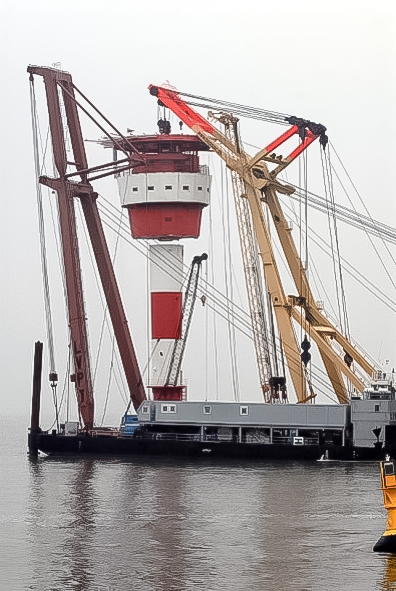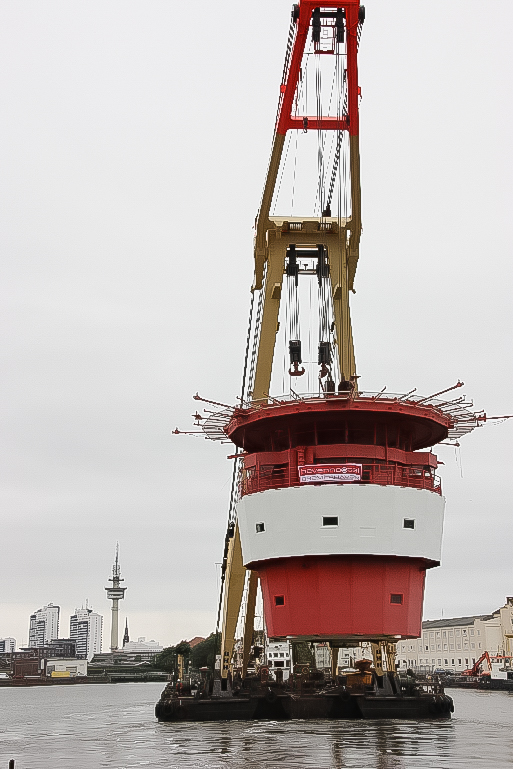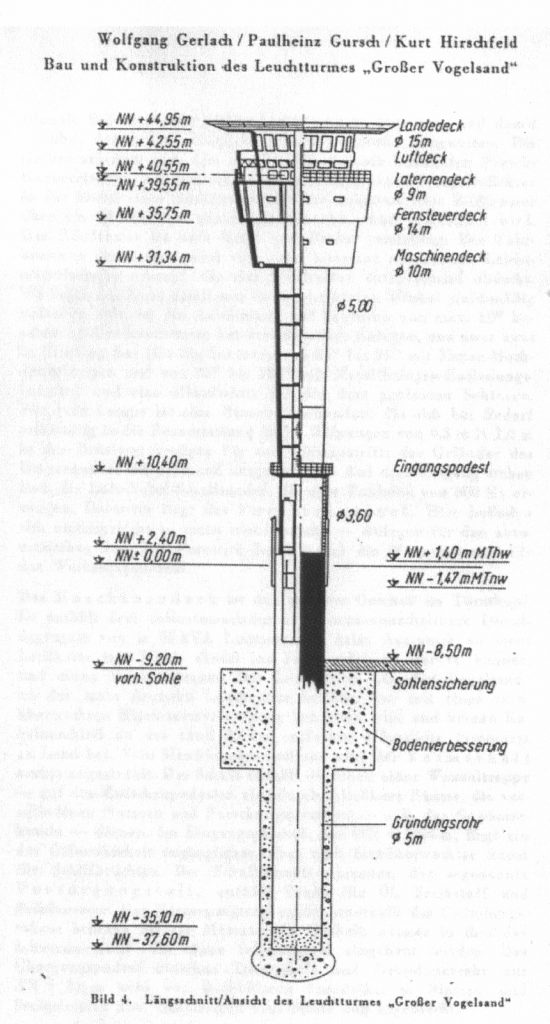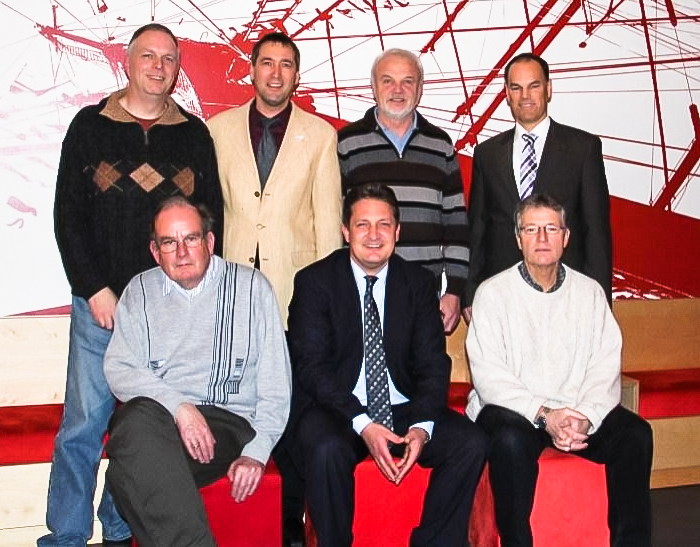The Großer Vogelsand beacon was a lighthouse in the mouth of the Elbe. Plans are currently underway to rebuild the tower at a height of about 39 metres and make it accessible to visitors.
With a viewing platform, exhibition space and a restaurant experience, the "haventurm" is set to become a new tourist attraction at the gateway to Bremerhaven's overseas port, offering a completely new view of the maritime city.
The tower, built in 1973 and 1974, was shut down at the end of the 1990s. In 2007, the Cuxhaven Waterways and Shipping Authority decided to dismantle the tower. In 2008, the lighthouse head was dismantled and taken to Bremerhaven for scrapping.
In order to save the technical monument from this fate, the entrepreneur and managing director of the havenhostel Bremerhaven, Jens Grotelüschen, acquired the upper part of the tower and had the 250-tonne, 3-storey head transported to its new destination, the grounds of the havenhostel, Bremerhaven, in a spectacular operation in June 2010.
After transferring the lighthouse to the Förderverein Maritimer Denkmalschutz e.V. (Maritime Monument Protection Association), which preserves maritime monuments and maintains buildings of maritime historical significance, the non-profit association is now taking over the reconstruction and future operation.
North of the Außenelbstrom lies the sandbank Großer Vogelsand, which was the bane of shipping until the 20th century. The Großer Vogelsand lighthouse, which carried leading lights, warning lights and orientation lights, was built to secure the mouth of the Elbe and was controlled fully automatically from Cuxhaven by directional radio.
Background
The particular danger posed by the shoal is, on the one hand, the weather conditions prevailing there and, on the other hand, the particularly fine sand, the so-called mill sand, which traps run-up ships and contributes to their breaking through. There are several hundred known and unknown wrecks there. The best known is the freighter Ondo, which beached there on 6 December 1961 and whose remains can still be seen today. The freighter Fides stranded there on 20 January 1962. Originally, the area was secured with floating beacons.
After the construction of the lighthouses Alte Weser (1964) and Tegeler Plate (1965) in the Outer Weser, the new method of flushing tower shafts completed on land into the seabed was also to be applied in the Elbe estuary.
Establishment
The lighthouse was built in 1973 and 1974, but the 82-metre-high tower, of which only 45 metres rose out of the water, did not go into operation until 23 May 1975, replacing the lightship Elbe 2. With a construction sum of DM 15 million, it became the most expensive lighthouse.
Due to technical developments and a shift in the Elbe navigation channel, the lighthouse became superfluous at the end of the 1990s. At the end of February 1999, the beacon was switched off again after only 24 years of operation. The fog signal was still in operation until 2004.
Attempts to use the tower as a hotel after it was decommissioned failed. In 2003, it was leased to the Helgoland Hotel Atoll. A second attempt was made in 2006 by Bremen's Hotel Überfluss. However, due to its limited accessibility, which depends on the weather, it was difficult to run the hotel.
Annual operating costs of over 125,000 euros led to the decision of the Cuxhaven Water and Shipping Authority in summer 2007 to have the lighthouse dismantled. In December 2008, the lighthouse head was dismantled from the shaft and taken by the floating crane Enak to Bremerhaven's fishing harbour, where it was to be scrapped. The shaft, which was also dismantled, was replaced by a steel tube that functions as a sea marker (beacon).


On 18 June 2010, the lighthouse head of Europe's once most modern and expensive lighthouse "Großer Vogelsand" was transported to the havenhostel Bremerhaven in a spectacular action.
The preliminary work had already been done by the floating crane Enak at the beginning of June, when it moved the 250-tonne head from Bremerhaven's fishing harbour to Kaiserhafen.
The steel colossus, which is around 15 metres high and 15 metres wide, covered the last few metres to its new destination by land in the city on 18 June 2010, from around 2:30 pm.
Although it is only 300 metres from the Roter Sand customs gate (Alter Fährweg) to the havenhostel, the excess width of the tower head necessitates planning prepared down to the smallest detail. Three traffic lights (Alter Fährweg/ Barkhausenstraße and intersection Barkhausenstraße/Rickmersstraße) were completely dismantled for the move so that the heavy transport could pass unhindered by traffic. Road unevenness was compensated for by a special control system for the loading area to prevent the tower head from falling over.
"There is great enthusiasm for the preservation of the lighthouse and the cooperation in the preparation of the move is exemplary," says Jens Grotelüschen, the initiator of the project. Thus, at a site meeting 14 days before the move, all 12 people involved from the offices, customs and the supply, construction and transport companies were also present to plan the process.
As soon as the crossing was completed, the customs fence was closed again and the reconstruction of the traffic lights was started in order to disrupt traffic as little as possible.
The lighthouse head will be "parked" on the havenhostel site until the necessary planning and preliminary work on the foundations, substructure and equipment for the new "haventurm" is completed.
| Function | Guide light |
| Location | Outer Elbe |
| Location | Sandbank Bird Sand |
| Geographical location | Latitude: 53° 59'18'' N Longitude: 8° 28'41'' E |
| Fire height | 39 m |
| Construction time | 1973 to 1974, deconstruction 16 Dec. 2008 |
| Operating time | 23 May 1975 until end of Feb. 1999 |
| Identifier | Blz.(3) 12 s, Glt. 3 s, Ubr. 6 s, Blz.(4) 15 s, Blz.(4) r. 15 s, Blz. r. 3 s, Ubr.(4) r. 18 s |
| Carrying capacity (white) | depending on direction, 19 to 26 nm |
| Carrying capacity (red) | directional, 9 to 12 nm |
| Optics | Fesnel lenses, precision sector lights |
| Audio signal | Horn Mo. (VS) 30 s, until 12 Jan. 2004, pitch 800 Hz |
| Design | Steel/iron |
| Comments | deleted and converted back to a navigation beacon |
| Int. serial number | B 1340 |
After extensive preparatory work, the tower shaft was washed almost 30 metres into the ground on the south side of the sandbank in 1973. The upper part, which was also prepared on land, was later put in place with a floating crane and then the cabling and technical equipment were completed.
Its function was primarily that of a guiding light, and also as an orientation light with a warning sector for the bird sand. In addition to a mirror rotating optic, the tower also had a belt optic, as well as marine radio beacons, a radar response beacon and an acoustic warning system (air fog sound system).
A separate engine deck housed the three truck-mounted diesel generators that provided the necessary electricity. Accordingly, the otherwise remote-controlled tower had to be approached regularly by the staff of the Cuxhaven Water and Shipping Authority to replenish operating materials.
The projecting three-storey upper part of the lighthouse also houses a helicopter landing pad. In addition, there were various emergency shelters for the maintenance personnel as well as for shipwrecked persons.The freely accessible entrance portal for receiving shipwrecked persons was monitored by a television camera. The maintenance personnel were dropped off at the tower by helicopter or buoy lighter.
Source: Die Bautechnik 1/1976)

The Förderverein Maritimer Denkmalschutz e.V., MDS for short, was founded in 1989. It has over 200 members, including more than 30 mutual corporate members, whom the association supports in word and deed in the fulfilment of their tasks.
With the aim of preserving maritime monuments, the association has realised numerous projects of its own in recent years and helped other associations to realise their projects. The aim is to contribute to the careful handling and preservation of historical harbour buildings and to preserve maritime memory.
The association promotes the care and preservation of maritime cultural monuments at numerous exhibitions, fairs and special events every year. In addition, the magazine "Maritimer Denkmalschutz" is published regularly.
The company's own projects include: The former pressurised water station "Altes Kraftwerk", the historic pressurised water slewing crane from 1899, the pilot transfer vessel "MS Seelotse" and many more.
Click here to go to the association's homepage.

Board of Directors of the Friends of the Earth and management of the office
Standing (from left to right):
Volker Siemers (Assessor)
Heinz Weber (Treasurer)
Manfred Benhof (Assessor)
Jens Grotelüschen (Chairman)
Seated (from left to right):
Manfred Schüler (Head of Association Office)
Lukas Schad (Secretary)
Michael Urlaub (Deputy Chairman)
Discover the exciting world of lighthouses, spectacularly located along the entire European coastline. The European Cultural Route of Lighthouses is designed to inspire exciting experiences and journeys across borders. The lighthouses vary greatly in architecture, landscape and accessibility, although their function has always been the same: to show sailors the way along the coast and into a safe harbour.